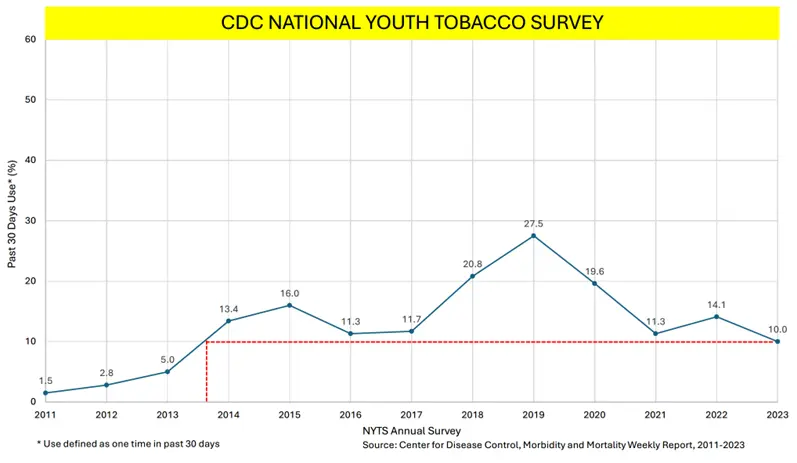FDA Spreading Misinformation About Teen Vaping Threat While Ignoring Greater Problem of Drug, Alcohol and Cigarette Use.

Published on April 12, 2024
Every year the government reports teen usage across alcohol, tobacco and drug substance categories. A quick look at the data shows that things are not what they seem. We are of course worried about underage use of any adult oriented product. But what the government’s own data show is media and government regulators hype the threat from teen vaping, which is in dramatic decline, while ignoring the growing and more concerning problem of kids drinking, taking opioids and other hard drugs, consuming cannabis in all its forms and even smoking cigarettes, in some cases at increasingly higher rates.
According to the CDC’s 2023 National Youth Tobacco Survey, the youth vaping rate (i.e., used once in the last 30 days) sits at 10%. This reflects a 60% decline in youth e-cigarette use between 2019 and 2023. Additionally, CDC researchers found that less than four percent of youth are vaping regularly. In fact, as demonstrated in the chart below, the youth vaping rate has plunged to levels not seen since 2013, before e-cigarettes were even regulated.

Importantly, this dramatic decline has occurred even with the dramatic increase in flavored vapes in the market, demonstrating that there is no real world connection between flavored vapes and youth use. If anything, there is an inverse correlation.
But what about kids that are drinking, doing drugs or even smoking cigarettes? Despite what we are being told, the concerning reality is that a significantly higher percentage of teens drink and do drugs than vape. According to a report authored by Dr. Robert J. Shapiro, a former Undersecretary for President Clinton, and former advisor to Presidents Obama and Biden, vaping among adolescents emerges as one of the less alarming “risk adolescent behaviors.” Nearly six percent of high schoolers are engaging in opioid use, five percent are using ecstasy or cocaine use, 11 percent engage in binge drinking, and 16 percent in regular marijuana.
To compare apples to apples – we compared the data from the National Youth Tobacco Survey, the Monitoring the Future Survey and other government data sources* concerning drug and alcohol use by underage users and the results are concerning. In short – a higher percent of teens now drink or do drugs monthly, than vape.
*In some cases only 2021 & 2022 data is available.
Teens are Increasingly Turning to Drugs and Alcohol
Teen Vaping
- 2023 NYTS data indicates a 41% drop in year-over-year teen vaping
- ~7.7% of teens report current use
- ~2.5% of teens are daily users
- Teen vaping has dropped 61% since 2019
Teen Alcohol Use
- 2021 NSDUH data indicates that 15.1% of teens are current users of alcohol
- Levels of teen alcohol use significantly increased between 2021 and 2022, returning to pre-pandemic levels. (Monitoring the Future)
- Teen past 30-day alcohol use is 3X higher than “current use” of nicotine vapes.
- Binge drinking (more than 5 drinks) is 50% higher than nicotine vaping
- Past 30-day alcohol use for 12th graders INCREASED from 29.3% to 33.6%
- 21% of 12th grader drinkers are current users of flavored alcohol
Teen Drug Use
- Among 12th grade students significant increases in 12th grade took place for past 30-day use of cocaine, hallucinogens, and heroin, as well as past 12-month use of prescription opioids.
- 31% of 12th grade students used cannabis in the past 12 months.
- 11.5% of 12-17 year olds used cannabis in the last 12 months.
- Teen past-30-day use (12th grade) has been stuck at around 20% for the past 25 years despite being both illegal and more harmful
Teen Smoking
- Teen smoking overall continues to decline – down 90% over the last decade
- Current use among all teens of combustible tobacco is 3.4%
- Past 30-day cigarette use for 12th graders, however, INCREASED from 5.7% to 7.5%
Misinformation and Misplaced Priorities Have Tragic Consequences
To date, no known deaths have been attributed to nicotine vaping. The same can not be said for drinking and drugs:
- According to the CDC, underage drinking was responsible for 4,000 deaths in 2022;
- According to the National Institute for Drug Abuse, overdose deaths among teenagers remains elevated with approximately 1,232 deaths in 2022;
- According to the American Academy of Pediatrics, the risk is not just for intentional users. Pediatric cannabis exposures have increased 1375% since 2017.
Considering this data, there are a number of uncomfortable questions that deserve rational, honest answers from federal regulators and politicians:
- Why is FDA promoting cannabis research to encourage descheduling marijuana when flavored marijuana vapes or, worse, cannabis gummies pose greater risks for youth than mere nicotine vapes?
- Why is Senator Chuck Schumer, one of the loudest voices for legalizing cannabis in all flavor varieties including edibles, also the loudest voice for banning flavored nicotine vapes?
- Why does the Biden-Harris Administration support marijuana legalization but stand by while their FDA removes all flavored vaping products from the market?
Why is a Bloomberg reporter editorializing that vaping devices should be used for cannabis instead of nicotine?
Flavored Vapes Are Not the Problem
The Center for Tobacco Products (CTP) under the leadership of Brian King has not approved a single vaping product since Biden took office. It has been well documented that adult smokers who wish to quit prefer flavored vapes. This fact is presented in the scientific literature including by the esteemed National Institutes of Health.
Yet, flavored alcohol and cannabis products are pervasive. Regulators, legislators and the media who advocate for cannabis are perpetuating the use of substances where the use and abuse actually causes documented harm to developing brains. The government’s own data shows that past 30-day alcohol use is three times higher than “current use” of nicotine vapes. Binge drinking is 50% higher. Past 30-day pot smoking is nearly 50% higher. This is where the real problem – and the hypocrisy – lies.
The Bottom Line
For years, regulators, lawmakers, and the media have painted teen vaping as the number one threat to our children’s health while pushing policies that increase our children’s exposure to truly dangerous substances. Teen smoking has dropped 90% over the past decade; total teen nicotine use is now at a 50-year low; teen nicotine vaping dropped 61% over the past 4 years. It’s time to start fighting the real fight.